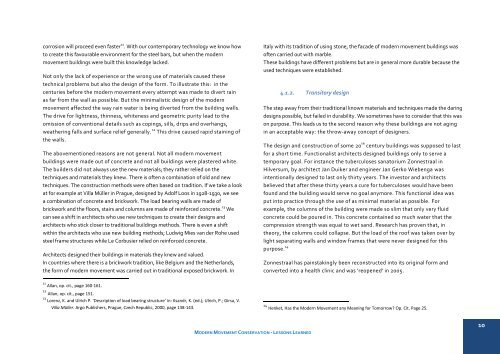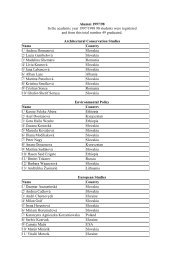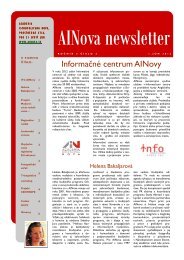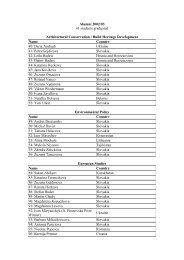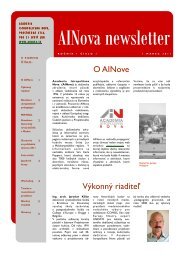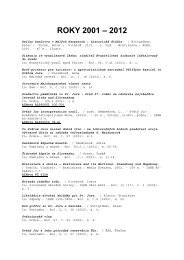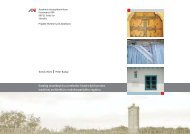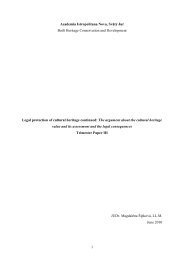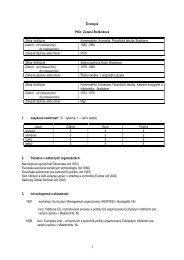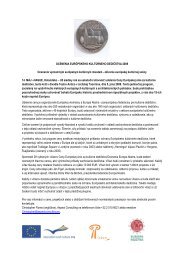modern movement modern movement conservations lessons learned
modern movement modern movement conservations lessons learned
modern movement modern movement conservations lessons learned
Create successful ePaper yourself
Turn your PDF publications into a flip-book with our unique Google optimized e-Paper software.
corrosion will proceed even faster 11 . With our contemporary technology we know howto create this favourable environment for the steel bars, but when the <strong>modern</strong><strong>movement</strong> buildings were built this knowledge lacked.Not only the lack of experience or the wrong use of materials caused thesetechnical problems but also the design of the form. To illustrate this: in thecenturies before the <strong>modern</strong> <strong>movement</strong> every attempt was made to divert rainas far from the wall as possible. But the minimalistic design of the <strong>modern</strong><strong>movement</strong> affected the way rain water is being diverted from the building walls.The drive for lightness, thinness, whiteness and geometric purity lead to theomission of conventional details such as copings, sills, drips and overhangs,weathering falls and surface relief generally. 12 This drive caused rapid staining ofthe walls.The abovementioned reasons are not general. Not all <strong>modern</strong> <strong>movement</strong>buildings were made out of concrete and not all buildings were plastered white.The builders did not always use the new materials; they rather relied on thetechniques and materials they knew. There is often a combination of old and newtechniques. The construction methods were often based on tradition. If we take a lookat for example at Villa Müller in Prague, designed by Adolf Loos in 1928-1930, we seea combination of concrete and brickwork. The load bearing walls are made ofbrickwork and the floors, stairs and columns are made of reinforced concrete. 13 Wecan see a shift in architects who use new techniques to create their designs andarchitects who stick closer to traditional buildings methods. There is even a shiftwithin the architects who use new building methods; Ludwig Mies van der Rohe usedsteel frame structures while Le Corbusier relied on reinforced concrete.Architects designed their buildings in materials they knew and valued.In countries where there is a brickwork tradition, like Belgium and the Netherlands,the form of <strong>modern</strong> <strong>movement</strong> was carried out in traditional exposed brickwork. InItaly with its tradition of using stone, the facade of <strong>modern</strong> <strong>movement</strong> buildings wasoften carried out with marble.These buildings have different problems but are in general more durable because theused techniques were established.4.1.2. Transitory designThe step away from their traditional known materials and techniques made the daringdesigns possible, but failed in durability. We sometimes have to consider that this wason purpose. This leads us to the second reason why these buildings are not agingin an acceptable way: the throw-away concept of designers.The design and construction of some 20 th century buildings was supposed to lastfor a short time. Functionalist architects designed buildings only to serve atemporary goal. For instance the tuberculoses sanatorium Zonnestraal inHilversum, by architect Jan Duiker and engineer Jan Gerko Wiebenga wasintentionally designed to last only thirty years. The investor and architectsbelieved that after these thirty years a cure for tuberculoses would have beenfound and the building would serve no goal anymore. This functional idea wasput into practice through the use of as minimal material as possible. Forexample, the columns of the building were made so slim that only very fluidconcrete could be poured in. This concrete contained so much water that thecompression strength was equal to wet sand. Research has proven that, intheory, the columns could collapse. But the load of the roof was taken over bylight separating walls and window frames that were never designed for thispurpose. 14Zonnestraal has painstakingly been reconstructed into its original form andconverted into a health clinic and was ‘reopened’ in 2005.11 Allan, op. cit., page 160-161.12 Allan, op. cit., page 151.13 Lorenz, K. and Ulrich P. ‘Description of load bearing structure’ in: Ksandr, K. (ed.); Ulrich, P.; Girsa, V.Villa Müller. Argo Publishers, Prague, Czech Republic, 2000, page 138-143.14 Henket, Has the Modern Movement any Meaning for Tomorrow? Op. Cit. Page 25.MODERN MOVEMENT CONSERVATION - LESSONS LEARNED10


